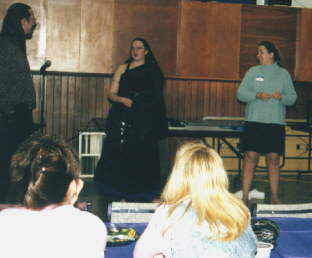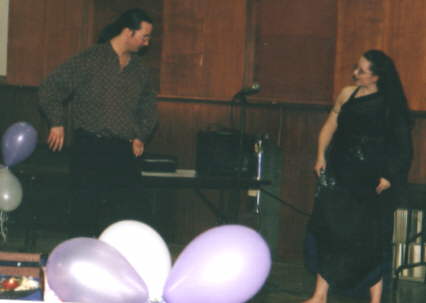

 The origins of bellydancing can be traced back to about 5000BC,
the time period when bellydancing is depicted in ancient Egyptian
paintings and carvings. The Gawazee, now known as Gypsies, came
from Rajastan and moved through Egypt, Spain and many other
countries around this time, which hints to much earlier origins
in Rajastan, although we have been unable thus far to find
concrete evidence to support this.
The origins of bellydancing can be traced back to about 5000BC,
the time period when bellydancing is depicted in ancient Egyptian
paintings and carvings. The Gawazee, now known as Gypsies, came
from Rajastan and moved through Egypt, Spain and many other
countries around this time, which hints to much earlier origins
in Rajastan, although we have been unable thus far to find
concrete evidence to support this.
The bellydance was also influenced by Turkey during the Ottoman Empire and the Sword dance traces it’s origins to Saudi Arabia. The dance was originally never performed in the presence of men. The origin of bellydancing lies solely with women and many of today’s modern bellydancers use this art as a celebration of feminine nature.
Bellydancing is very helpful in preparation for childbirth. By strengthening the stomach, uterine and back muscles, a woman’s body is prepared to undergo a much quicker and less painful childbirth. The practice of bellydancing focuses on gradually strengthening and improving muscle control, rather than on aerobic/heart and lung capacity. Thus, it is an ideal regular exercise activity for any pregnant woman. When actually performed during labor and the birthing process, the intense movements and practiced muscle vibrations actually help to alleviate birth pains. The stomach roll that is used during the dance is very therapeutic for soon to be mothers. The upper part of the roll should be held between contractions, which opens the chest cavity, allowing better air circulation in the lungs while it tenses the uterine muscles in preparation for the next contraction. The lower part of the roll during contractions will bear down on the womb, allowing abdominal and pelvic muscles to stretch without tearing. There was a time when women would gather in the birth tent with the expectant mother and perform this dance around her. The mother would often times, join in the dance between and even during contractions. She would stand or squat above a fur-lined dug-out in the floor which was lined and prepared to catch the baby as it was delivered by its dancing mother. Men were never allowed near these tents. Instead, they gathered outside and celebrated the coming birth, providing music for the dance.
Bellydancing made it’s way to America in 1893 when a Hungarian group performed in the Chicago World’s Fair. It spread across the border into Canada very quickly. Visitors to the 1893 World’s Fair expected to see ladies with their bodies fully covered in layers of cloth, strapped into rigid corsets and wide skirts. What they found was a group of very exotic-looking ladies wearing some very unaccepted clothing. Although their bodies were fully covered, they appeared in flowing, alluring dresses with long sheer, shimmering veils moving to a very sensuous dance. Unfortunately, this type of dance was then deemed “risqué” and “improper” for a lady to study, and it’s reputation plummeted among the masses.
During recent years, bellydancers have been working very hard to overcome this “exotic dancer” stereotype. When we hear the term “exotic dancer”, we tend to think of a stripper rather than a bellydancer. Bellydancing is not a “nasty” or “dirty” dance, but it does have an inherent sensual nature that is obvious to anyone who watches the dance. It is, indeed exotic in it’s origin, rich in history and beauty. This is a beautiful and historic art form that is still evolving, as are the instruments and music that the dance is set to. Bellydancing uses the body as the Temple of the Soul and helps us to create a healthy body through practicing proper movement and interaction with music.
There are two basic forms of bellydancing: Cabaret and Traditional.
The cabaret style, which is what we often see performed in clubs and shows, is fast and energetic. Cabaret bellydancers usually wear flashy costumes that show a good deal of bare skin.
Traditional dancing, which is what we will focus on, is slow and very graceful. It is usually performed with the body fully covered.
Although there are different styles of bellydancing, the techniques used are basically the same.
There are four moves that are unique to this dance:
circular midriff rhythms
angular hip rotations
stomach vibrating
stomach rolls
The circular midriff rhythms are attained by moving the hips to one side of the body, shifting them forward then back and repeating on the other side of the body while keeping the shoulders as still as possible. This simple move is one of the most common in the dance, along with the angular hip rotations.
Angular hips rotations are accomplished by bending the knees, standing with one foot slightly in front and to the side of the other and moving the hips from the stationary position in a slight arc upwards to the side and back down. This move is often done to a fast rhythm where it will appear as more of a bounce of the hip to one side. When performed to a slow accompaniment, this move can be easily seen in it’s full form.
Stomach vibrations are one of the more interesting parts of this dance, and also one of the most difficult. Most often referred to as “The Flutter”, this is done by tensing the muscles from the diaphragm to the pelvis and panting in a manner very similar to lamaz-breathing. After a bit of practice with the muscle control needed to show this move, you will notice a slight “flutter” in your stomach muscles when you do this. This is one of the more difficult actions in bellydancing, but a dance can be performed beautifully and effectively without using “The Flutter”.
Stomach rolls are another mainstay of bellydancing. When people envision a bellydancer, she is usually performing this. This is also a difficult move to master and requires immense muscle control to effectively perform for any extended period of time. This is performed by tensing the muscles of your stomach and “rolling” them to the bottom of the abdomen. Some people find it very helpful to put their hands on top of their stomachs and feel the roll, maybe even helping the muscles out with their hands until they get practiced. Although it is one of the hardest parts of the dance, it is this move that people are the most fascinated with.
Today, bellydancers can be seen in many places, not just in tribal birth tents or dancing to a ritualistic drum rhythm. Most cities have cabaret bellydancers who perform in places ranging from night clubs to restaurants and sidewalks. If you ever get the chance to see a good cabaret show, you should go! It is a beautiful dance and the costumes, however flashy some may be, do enhance the mood set by the dance. It is much more difficult to find a traditional bellydancer that will perform. If you chance upon one, it is a one in a million opportunity and it is definitely something that will be enriching.
Check out more pictures of the bellydancing from the event at Spirit Festival Pictures.







